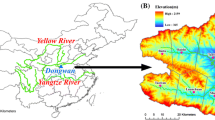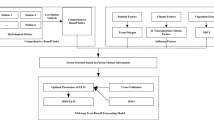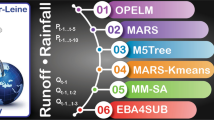Abstract
An ensemble artificial neural network (ENN) based hybrid function approximator (named PEK), integrating the partial mutual information (PMI) based separate input variable selection (IVS) scheme, ENN-based output estimation, and K-nearest neighbor regression based output error estimation, has been proposed to improve event-based rainfall-runoff (RR) simulation. A hybrid data-driven RR model, named non-updating PEK (NU-PEK), is also developed on the basis of the PEK approximator. The rainfall and simulated antecedent discharges input variables for the NU-PEK model are selected separately by using a PMI-based IVS algorithm. A newly proposed candidate rainfall input set, sliding window cumulative rainfall is also proposed. These two methods are integrated to make a good compromise between the adequacy and parsimony of the input information and make contribution to the understandings of the hydrologic responses to the regional precipitation. The number of component networks and the topology and parameter settings of each component network are optimized simultaneously by using the multi-objective NSGA-II optimization algorithm and the early stopping Levenberg–Marquardt algorithm. The optimal combination weights of the ENN are obtained according to the Akaike information criterions of component networks. By combining all these methods, the simulation accuracy and generalization property of the PEK approximator are much better than traditional artificial neural network. The NU-PEK model is constructed by combining the PEK approximator with a newly proposed non-updating modeling approach to improve event-based RR simulation. The NU-PEK model was applied to three Chinese catchments for RR simulation and compared with two popular RR models, including the conceptual Xinanjiang model and the conceptual-data-driven IHACRES model. The results of simulation and sensitivity analysis indicate that the developed model generally outperforms the other two models. The NU-PEK model is capable of producing high accuracy non-updating RR simulation without the use of the real-time information, e.g. the observed discharges at previous time steps.













Similar content being viewed by others
References
Admuthe L, Apte S, Admuthe S (2009) Topology and parameter optimization of ANN using genetic algorithm for application of textiles. IEEE International Workshop on Intelligent Data Acquisition and Advanced Computing Systems: Technology and Applications, pp 21–23
Aziz K, Rahman A, Fang G, Shrestha S (2014) Application of artificial neural networks in regional flood frequency analysis: a case study for Australia. Stoch Environ Res Risk Assess 28(3):541–554
Bagtzoglou AC, Hossain F (2009) Radial basis function neural network for hydrologic inversion: an appraisal with classical and spatio-temporal geostatistical techniques in the context of site characterization. Stoch Environ Res Risk Assess 23(7):933–945
Bowden GJ, Dandy GC, Maier HR (2005a) Input determination for neural network models in water resources applications. Part 1-background and methodology. J Hydrol 301:75–92
Bowden GJ, Maier HR, Dandy GC (2005b) Input determination for neural network models in water resources applications. Part 2. Case study: forecasting salinity in a river. J Hydrol 301:93–107
Carcano EC, Bartolini P, Muselli M, Piroddi L (2008) Jordan recurrent neural network versus IHACRES in modelling daily streamflows. J Hydrol 362:291–307
Cheng X, Noguchi M (1996) Rainfall-runoff modeling by neural network approach. In: Proceedings of the International Conference on Water Resource and Environment Reasearch, vol (II), pp 143–150
Chiang Y, Chang L, Chang F (2004) Comparison of static-feedforward and dynamic feedback neural networks for rainfall-runoff modeling. J Hydrol 290:297–311
Chua HCL, Wong TSW, Sriramula LK (2008) Comparison between kinematic wave and artificial neural network models in event-based runoff simulation for an overland plane. J Hydrol 357:337–348
Coulibaly P, Anctil F, Bobée B (2000) Daily reservoir inflow forecasting using artificial neural networks with stopped training approach. J Hydrol 230:244–257
de Vos NJ, Rientjes THM (2005) Constraints of artificial neural networks for rainfall-runoff modelling: trade-offs in hydrological state representation and model evaluation. Hydrol Earth Syst Sci 9:111–126
Deb K, Pratap A, Agarwal S, Meyarivan T (2002) A fast and elitist multiobjective genetic algorithm: NSGA-II. IEEE Trans Evolut Computat 6(2):182–197
Ding S, Su C, Yu J (2011) An optimizing BP neural network algorithm based on genetic algorithm. Artif Intell Rev 36:153–162
Duan Q, Sorooshian S, Gupta VK (1992) Effective and efficient global optimization for conceptual rainfall-runoff models. Water Resour Res 28(4):1015–1031
Duan Q, Gupta VK, Sorooshian S (1993) A shuffled complex evolution approach for effective and efficient optimization. J Optim Theory Appl 76(3):501–521
Duan Q, Sorooshian S, Gupta VK (1994) Optimal use of the SCE-UA global optimization method for calibrating watershed models. J Hydrol 158:265–284
Gao C, Gemmer M, Zeng X, Liu B, Su B, Wen Y (2010) Projected streamflow in the Huaihe River Basin (2010–2100) using artificial neural network. Stoch Environ Res Risk Assess 24(5):685–697
Guo J, Zhou J, Song L, Zou Q, Zeng X (2013) Uncertainty assessment and optimization of hydrological model with the Shuffled Complex Evolution Metropolis algorithm: an application to artificial neural network rainfall-runoff model. Stoch Environ Res Risk Assess 27(4):985–1004
Halff AH, Halff HM, Azmoodeh M (1993) Predicting runoff from rainfall using neural networks In: Proceedings of the engineering hydrology, ASCE, pp 760–765
Jain A, Srinivasulu S (2004) Development of effective and efficient rainfall-runoff modeling using integration of deterministic, real-coded genetic algorithms and artificial neural network techniques. Water Resour Res 40:W04302
Jain A, Srinivasulu S (2006) Integrated approach to model decomposed flow hydrograph using artificial neural network and conceptual techniques. J Hydrol 317:291–306
Jakeman AJ, Littlewood IG, Whitehead PG (1990) Computation of the instantaneous unit hydrograph and identifiable component flow with application to small upload catchments. J Hydrol 117:275–300
Ju Q, Yu Z, Hao Z, Ou G, Zhao J, Liu D (2009) Division-based rainfall-runoff simulations with BP neural networks and Xinanjiang model. Neurocomputing 72:2873–2883
Kan G, Liu Z, Li Z, Yao C, Zhou S (2012) Coupling Xinanjiang runoff generation model with improved BP flow concentration model. Adv Water Sci 23(1):21–28 (in Chinese)
Kan G, Li Z, Liu Z, Li Q, Hu Y (2013a) An improved neural network model and its application to hydrological simulation. J Hohai Univ (Natural Sciences) 41(4):294–299 (in Chinese)
Kan G, Li Z, Liu Z, Yao C, Zhang H (2013b) Application and study on coupling of conceptual hydrological model and neural network model. J Hydroelec Eng 32(2):9–21 (in Chinese)
Kanal L (1974) Patterns in pattern recognition. IEEE Trans Inf Theory IT20:697–722
Kasiviswanathan KS, Sudheer KP (2013) Quantification of the predictive uncertainty of artificial neural network based river flow forecast models. Stoch Environ Res Risk Assess 27(1):137–146
Kumar ARS, Sudheer KP, Jain SK, Agarwal PK (2005) Rainfall-runoff modeling using artificial neural networks: comparison of network types. Hydrol Process 19:1277–1291
Li H, Zhang Y, Chiew FHS, Xu S (2009) Predicting runoff in ungauged catchments by using Xinanjiang model with MODIS leaf area index. J Hydrol 370:155–162
Li Z, Kan G, Yao C, Liu Z, Li Q, Yu S (2014a) An improved neural network model and its application in hydrological simulation. J Hydrol Eng 19(10):04014019
Li C, Tang H, Ge Y, Hu X, Wang L (2014b) Application of back-propagation neural network on bank destruction forecasting for accumulative landslides in the three Gorges Reservoir Region, China. Stoch Environ Res Risk Assess 26(6):1465–1477
Loghmanian SMR, Ahmad HJR, Khalid RYM (2012) Structure optimization of neural network for dynamic system modeling using multi-objective genetic algorithm. Neural Comput Appl 21:1281–1295
Lü H, Hou T, Horton R, Zhu Y, Chen X, Jia Y, Wang W, Fu X (2013) The streamflow estimation using the Xinanjiang rainfall runoff model and dual state-parameter estimation method. J Hydrol 480:102–114
May RJ, Dandy GC, Maier HR, Nixon JB (2008) Application of partial mutual information variable selection to ANN forecasting of water quality in water distribution systems. Environ Model Softw 23(10–11):1289–1299
Minns AW, Hall MJ (1996) Artificial neural networks as rainfall-runoff models. Hydrol Sci J 41(3):399–417
Nash JE, Sutcliffe JV (1970) River flow forecasting through conceptual models; part I—a discussion of principles. J Hydrol 10:282–290
Natale N, Todini E (1974) A constrained parameter estimation technique for linear models in hydrology. Institute of Hydraulics, University of Pavia, Pavia, Italy (publ. 13)
Paleologos EK, Skitzi I, Katsifarakis K, Darivianakis N (2013) Neural network simulation of spring flow in Karst environments. Stoch Environ Res Risk Assess 27(8):1829–1873
Panchal G, Ganatra A, Kosta YP (2010) Searching most efficient neural network architecture using Akaike’s information criterion (AIC). Int J Comput Appl 1(5):975–8887
Panu US, Unny TE (1979) Application of feature prediction model in hydrologic time series synthesis. In: McBean AE, Hipel KW, Unny TE (eds) Inputs for risk and analysis in water systems. Water Resources Publications, Fort Collins, CO, pp 315–338
Piotrowski AP, Napiorkowski JJ (2013) A comparison of methods to avoid overfitting in neural networks training in the case of catchment runoff modeling. J Hydrol 476:97–111
Rajurkar MP, Kothyari UC, Chaube UC (2004) Modeling of daily rainfall-runoff relationship with artificial neural network. J Hydrol 285:96–113
Shamseldin AY (1997) Application of a neural network technique to rainfall-runoff modeling. J Hydrol 199(3–4):272–294
Shamseldin AY, O’Connor KO (1996) A nearest neighbour linear perturbation model for river flow forecasting. J Hydrol 179:352–375
Sharma A (2000a) Seasonal to interannual rainfall probabilistic forecasts for improved water supply management: part 1—a strategy for system predictor identification. J Hydrol 239(1–4):232–239
Sharma A (2000b) Seasonal to interannual rainfall probabilistic forecasts for improved water supply management: part 3—a nonparametric probabilistic forecast model. J Hydrol 239(1–4):249–258
Sharma A, Luk KC, Cordery I, Lall U (2000) Seasonal to interannual rainfall probabilistic forecasts for improved water supply management: part 2—predictor identification of quarterly rainfall using ocean-atmosphere information. J Hydrol 239(1–4):240–248
Singh P, Borah B (2013) Indian summer monsoon rainfall prediction using artificial neural network. Stoch Environ Res Risk Assess 27(7):1585–1599
Smith MB, Seo D, Koren VI, Reed SM, Zhang Z, Duan Q, Moreda F, Cong S (2004) The distributed model intercomparison project (DMIP): motivation and experiment design. J Hydrol 298:4–26
Sollich P, Krogh A (1996) Learning with ensembles: how over-fitting can be useful. In: Touretzky DS, Mozer MC, Hasselmo ME (eds) Advances in neural information processing systems 8. MIT press, Cambridge, MA, pp 190–196
Tayfur G, Singh VP (2006) ANN and fuzzy logic models for simulating event-based rainfall-runoff. J Hydraul Eng 132(12):1321–1330
Todini E, Wallis JR (1974) Using CLS for daily or longer period rainfall-runoff modeling. Institute of Hydraulics, University of Pavia, Pavia (Publ 13)
Tokar AS, Markus M (2000) Rainfall-runoff modeling using artificial neural networks and conceptual models. J Hydrol Eng 5(2):156–161
Yu J, Wang S, Xi L (2008) Evolving artificial neural networks using an improved PSO and DPSO. Neurocomputing 71:1054–1060
Yurdusev MA, Firat M, Turan ME, Sinir BG (2009) Neural networks and fuzzy inference systems for predicting water consumption time series. Stoch Environ Res Risk Assess 23(8):1225
Zhang D, Cai K (2003) A genetic-algorithm-based two-stage learning scheme for neural networks. J Syst Simulat 15(8):1088–1090 (in Chinese)
Zhao R (1984) Watershed hydrological modeling—Xinanjiang model and northern Shaanxi model. China Water Power, Beijing, China, pp 126–127 (in Chinese)
Zhao R (1992) The Xinanjiang model applied in China. J Hydrol 135:371–381
Zhao R, Zhang Y, Fang L, Liu X, Zhang Q (1980) The Xinanjiang model. In: Hydrological forecasting proceedings Oxford symposium, IAHS, pp 351–356
Zhao Z, Zhang Y, Liao H (2008) Design of ensemble neural network using the Akaike information criterion. Eng Appl Artif Intell 21:1182–1188
Acknowledgments
This research was funded by the NNSF of China (Nos. 41130639, 51179045, 41101017, and 41201028), the Research and Innovation Program of Graduate of Colleges and Universities of Jiangsu Province China (No. CXZZ11_0435), the Specific Research of China Institute of Water Resources and Hydropower Research (No. Fangji 1240), the National Science and Technology Support Project (No. 2012BAK10B04), and the China Institute of Water Resource and Hydropower Research under the Project “Numerical model for flow simulation in 1D complex channel networks based on the Godunov method” (No. JZ0145B032014).
Author information
Authors and Affiliations
Corresponding author
Rights and permissions
About this article
Cite this article
Kan, G., Yao, C., Li, Q. et al. Improving event-based rainfall-runoff simulation using an ensemble artificial neural network based hybrid data-driven model. Stoch Environ Res Risk Assess 29, 1345–1370 (2015). https://doi.org/10.1007/s00477-015-1040-6
Published:
Issue Date:
DOI: https://doi.org/10.1007/s00477-015-1040-6




